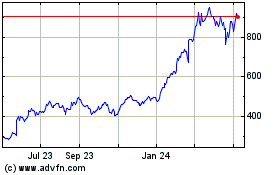CES --
NVIDIA today
unveiled the most advanced consumer GPUs for gamers, creators and
developers — the GeForce RTX™ 50 Series Desktop and Laptop GPUs.
Powered by the NVIDIA Blackwell architecture, fifth-generation
Tensor Cores and fourth-generation RT Cores, the GeForce RTX 50
Series delivers breakthroughs in AI-driven rendering, including
neural shaders, digital human technologies, geometry and
lighting.
“Blackwell, the engine of AI, has arrived for PC gamers,
developers and creatives,” said Jensen Huang, founder and CEO of
NVIDIA. “Fusing AI-driven neural rendering and ray tracing,
Blackwell is the most significant computer graphics innovation
since we introduced programmable shading 25 years ago.”
The GeForce RTX 5090 GPU — the fastest GeForce RTX GPU to date —
features 92 billion transistors, providing over 3,352 trillion AI
operations per second (TOPS) of computing power. Blackwell
architecture innovations and DLSS 4 mean the GeForce RTX 5090 GPU
outperforms the GeForce RTX 4090 GPU by up to 2x.
GeForce Blackwell comes to laptops with all the features of
desktop models, bringing a considerable upgrade to portable
computing, including extraordinary graphics capabilities and
remarkable efficiency. The Blackwell generation of NVIDIA Max-Q
technology extends battery life by up to 40%, and includes thin and
light laptops that maintain their sleek design without sacrificing
power or performance.
NVIDIA DLSS 4 Boosts Performance by Up to
8xDLSS 4 debuts Multi Frame Generation to boost frame
rates by using AI to generate up to three frames per rendered
frame. It works in unison with the suite of DLSS technologies to
increase performance by up to 8x over traditional rendering, while
maintaining responsiveness with NVIDIA Reflex technology.
DLSS 4 also introduces the graphics industry’s first real-time
application of the transformer model architecture.
Transformer-based DLSS Ray Reconstruction and Super Resolution
models use 2x more parameters and 4x more compute to provide
greater stability, reduced ghosting, higher details and enhanced
anti-aliasing in game scenes. DLSS 4 will be supported on GeForce
RTX 50 Series GPUs in over 75 games and applications the day of
launch.
NVIDIA Reflex 2 introduces Frame Warp, an innovative technique
to reduce latency in games by updating a rendered frame based on
the latest mouse input just before it is sent to the display.
Reflex 2 can reduce latency by up to 75%. This gives gamers a
competitive edge in multiplayer games and makes single-player
titles more responsive.
Blackwell Brings AI to ShadersTwenty-five years
ago, NVIDIA introduced GeForce 3 and programmable shaders, which
set the stage for two decades of graphics innovation, from pixel
shading to compute shading to real-time ray tracing. Alongside
GeForce RTX 50 Series GPUs, NVIDIA is introducing RTX Neural
Shaders, which brings small AI networks into programmable shaders,
unlocking film-quality materials, lighting and more in real-time
games.
Rendering game characters is one of the most challenging tasks
in real-time graphics, as people are prone to notice the smallest
errors or artifacts in digital humans. RTX Neural Faces takes a
simple rasterized face and 3D pose data as input, and uses
generative AI to render a temporally stable, high-quality digital
face in real time.
RTX Neural Faces is complemented by new RTX technologies for
ray-traced hair and skin. Along with the new RTX Mega Geometry,
which enables up to 100x more ray-traced triangles in a scene,
these advancements are poised to deliver a massive leap in realism
for game characters and environments.
The power of neural rendering, DLSS 4 and the new DLSS
transformer model is showcased on GeForce RTX 50 Series GPUs with
Zorah, a groundbreaking new technology demo from NVIDIA.
Autonomous Game CharactersGeForce RTX 50 Series
GPUs bring industry-leading AI TOPS to power autonomous game
characters in parallel with game rendering.
NVIDIA is introducing a suite of new NVIDIA ACE technologies
that enable game characters to perceive, plan and act like human
players. ACE-powered autonomous characters are being integrated
into KRAFTON’s PUBG: BATTLEGROUNDS and InZOI, the publisher’s
upcoming life simulation game, as well as Wemade Next’s MIR5.
In PUBG, companions powered by NVIDIA ACE plan and execute
strategic actions, dynamically working with human players to ensure
survival. InZOI features Smart Zoi characters that autonomously
adjust behaviors based on life goals and in-game events. In MIR5,
large language model (LLM)-driven raid bosses adapt tactics based
on player behavior, creating more dynamic, challenging
encounters.
AI Foundation Models for RTX AI PCsShowcasing
how RTX enthusiasts and developers can use NVIDIA NIM microservices
to build AI agents and assistants, NVIDIA will release a pipeline
of NIM microservices and AI Blueprints for RTX AI PCs from top
model developers such as Black Forest Labs, Meta, Mistral and
Stability AI.
Use cases span LLMs, vision language models, image generation,
speech, embedding models for retrieval-augmented generation, PDF
extraction and computer vision. The NIM microservices include all
the necessary components for running AI on PCs and are optimized
for deployment across all NVIDIA GPUs.
To demonstrate how enthusiasts and developers can use NIM to
build AI agents and assistants, NVIDIA today previewed Project R2X,
a vision-enabled PC avatar that can put information at a user’s
fingertips, assist with desktop apps and video conference calls,
read and summarize documents, and more.
AI-Powered Tools for CreatorsThe GeForce RTX 50
Series GPUs supercharge creative workflows. RTX 50 Series GPUs are
the first consumer GPUs to support FP4 precision, boosting AI image
generation performance for models such as FLUX by 2x and enabling
generative AI models to run locally in a smaller memory footprint,
compared with previous-generation hardware.
The NVIDIA Broadcast app gains two AI-powered beta features for
livestreamers: Studio Voice, which upgrades microphone audio, and
Virtual Key Light, which relights faces for polished streams.
Streamlabs is introducing the Intelligent Streaming Assistant,
powered by NVIDIA ACE and Inworld AI, which acts as a cohost,
producer and technical assistant to enhance livestreams.
AvailabilityFor desktop users, the GeForce RTX
5090 GPU with 3,352 AI TOPS and the GeForce RTX 5080 GPU with 1,801
AI TOPS will be available on Jan. 30 at $1,999 and $999,
respectively.
The GeForce RTX 5070 Ti GPU with 1,406 AI TOPS and GeForce RTX
5070 GPU with 988 AI TOPS will be available starting in February at
$749 and $549, respectively.
The NVIDIA Founders Editions of the GeForce RTX 5090, RTX 5080
and RTX 5070 GPUs will be available directly from nvidia.com and
select retailers worldwide.
Stock-clocked and factory-overclocked models will be available
from top add-in card providers such as ASUS, Colorful, Gainward,
GALAX, GIGABYTE, INNO3D, KFA2, MSI, Palit, PNY and ZOTAC, and in
desktops from system builders including Falcon Northwest,
Infiniarc, MAINGEAR, Mifcom, ORIGIN PC, PC Specialist and Scan
Computers.
Laptops with GeForce RTX 5090, RTX 5080 and RTX 5070 Ti Laptop
GPUs will be available starting in March, and RTX 5070 Laptop GPUs
will be available starting in April from the world’s top
manufacturers, including Acer, ASUS, Dell, GIGABYTE, HP, Lenovo,
MECHREVO, MSI and Razer.
About NVIDIANVIDIA (NASDAQ: NVDA) is the world
leader in accelerated computing.
For further information, contact:Ben
BerraondoNVIDIA Corporation+1-669-271-5730bberraondo@nvidia.com
Certain statements in this press release including, but not
limited to, statements as to: the benefits, impact, performance and
availability of NVIDIA’s products, services, and technologies,
including GeForce RTX 50 Series Desktop and Laptop GPUs, NVIDIA
Blackwell architecture, fifth-generation Tensor Cores,
fourth-generation RT Cores, GeForce RTX 5090 Founders Edition GPU,
NVIDIA DLSS 4, NVIDIA Reflex, DLSS Multi Frame Generation, DLSS
Super Resolution and Ray Reconstruction models, NVIDIA Reflex 2,
RTX Neural Shaders, RTX Neural Faces, RTX Mega Geometry, ACE
technologies, NVIDIA NIM microservices, Project R2X, RTX 40 Series
GPUs, NVIDIA RTX Remix modding platform and D5 Render, NVIDIA
Broadcast, Studio Voice, Virtual Key Light, GeForce Blackwell,
NVIDIA Max-Q technology, GeForce RTX 5090, GeForce RTX 5080,
GeForce RTX 5070 Ti, and GeForce RTX 5070, GeForce RTX 5090 Laptop
GPU, GeForce RTX 5080 Laptop GPU, GeForce RTX 5070 Ti Laptop GPU,
GeForce RTX 5070 Laptop GPU; and third parties adopting NVIDIA’s
products and technologies are forward-looking statements that are
subject to risks and uncertainties that could cause results to be
materially different than expectations. Important factors that
could cause actual results to differ materially include: global
economic conditions; our reliance on third parties to manufacture,
assemble, package and test our products; the impact of
technological development and competition; development of new
products and technologies or enhancements to our existing product
and technologies; market acceptance of our products or our
partners' products; design, manufacturing or software defects;
changes in consumer preferences or demands; changes in industry
standards and interfaces; unexpected loss of performance of our
products or technologies when integrated into systems; as well as
other factors detailed from time to time in the most recent reports
NVIDIA files with the Securities and Exchange Commission, or SEC,
including, but not limited to, its annual report on Form 10-K and
quarterly reports on Form 10-Q. Copies of reports filed with the
SEC are posted on the company's website and are available from
NVIDIA without charge. These forward-looking statements are not
guarantees of future performance and speak only as of the date
hereof, and, except as required by law, NVIDIA disclaims any
obligation to update these forward-looking statements to reflect
future events or circumstances.
Many of the products and features described herein remain in
various stages and will be offered on a when-and-if-available
basis. The statements above are not intended to be, and should not
be interpreted as a commitment, promise, or legal obligation, and
the development, release, and timing of any features or
functionalities described for our products is subject to change and
remains at the sole discretion of NVIDIA. NVIDIA will have no
liability for failure to deliver or delay in the delivery of any of
the products, features or functions set forth herein.
© 2025 NVIDIA Corporation. All rights reserved. NVIDIA, the
NVIDIA logo GeForce and NVIDIA NIM are trademarks and/or registered
trademarks of NVIDIA Corporation in the U.S. and other countries.
Other company and product names may be trademarks of the respective
companies with which they are associated. Features, pricing,
availability and specifications are subject to change without
notice.
A photo accompanying this announcement is available at
https://www.globenewswire.com/NewsRoom/AttachmentNg/1cf5396b-b8ff-4b1b-b868-9af87dd6b7c6
NVIDIA (NASDAQ:NVDA)
Historical Stock Chart
From Dec 2024 to Jan 2025

NVIDIA (NASDAQ:NVDA)
Historical Stock Chart
From Jan 2024 to Jan 2025
